Read more
(Lucca, 1603 - Lucca, 1681)
Portrait of Tiberio Fiorilli as Scaramouche
Oil on canvas
92.5 x 121 cm
Trace of an inscription lower right: 78.
Provenance
Possibly Madrid, collection of Diego Messia, Marquis of Leganés (Madrid, 1580–1655), political and military figure.
Madrid, collection of Vicente Joaquín Ossorio de Moscoso y Ponce de León, Count of Altamira (Madrid, 1801–1864), passed by inheritance, post-mortem inventory 13–14 March 1864, no. 78.
Madrid, collection of the Álava family.
Madrid, passed by inheritance, private collection until 2014.
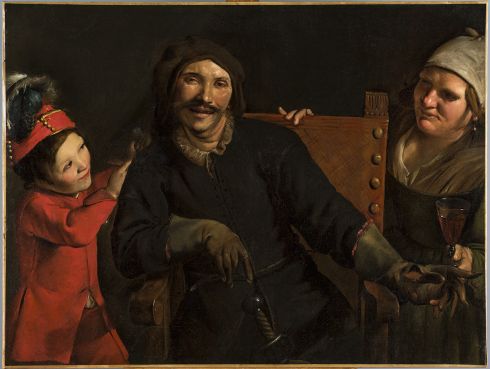
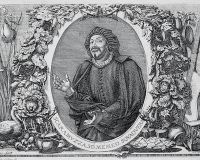
ill. 1. Jean Lepautre (attribué à), d’après Henri Gissey (?), Scaiamuzza so Memeo Squaqueia. Gravure, collection particulière.
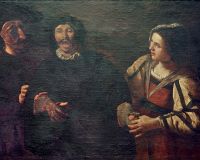
ill. 2. Pietro Paolini, Tiberio Fiorilli en Scaramouche. Huile sur toile, 92 x 130 cm. Collection particulière.
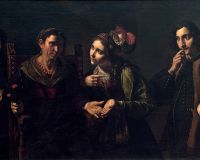
ill. 3. Pietro Paolini, La Bonne Aventure. Huile sur toile, 108 x 170,2 cm. Auckland Art Gallery Toi o Tamaki.
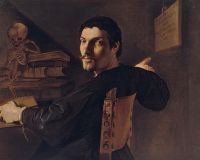
ill. 4. Pietro Paolini, Portrait d’homme. Huile sur toile, dimensions inconnues. Collection particulière.
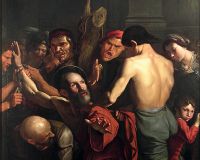
ill. 5. Pietro Paolini, Martyre de saint Bartholomé. Huile sur toile, 253 x 173 cm. Lucques, Museo Nazionale di Villa Guinigi.
AN IMPORTANT “THEATRICAL” PAINTING BY PIETRO PAOLINI
Showing the actor Tiberio Fiorilli in the role of Scaramouche and flanked by two fellow-players, this remarkable picture is as important for the history of art as for that of the theatre. Fiorilli (Naples, 1608 – Paris, 1694) was famed for his interpretation of this burlesque character, whom he inherited from his older brother Giovan Battista and performed for Italian and French audiences for more than half a century. Assessment of Fiorilli’s importance in the Italian theatre only began fairly recently: the 1980s in particular saw the publication of detailed studies, together with the discovery of documents throwing new light on his personality.1 For centuries his face and life were identified with those of his stage character, notably because of the enormous success of Angelo Costantini’s La Vie de Scaramouche [A Pleasant and Comical History of the Life of Scaramouche], influenced by Spanish picaresque novels and published in 1695,2 not long after Fiorilli’s death.
Scaramouche (or Scaramuccia) has his origins in the capitan, the quarrelsome Neapolitan with a tendency to flee the fights he regularly provokes. While keeping the character’s black suit, typical of the Spanish nobility, Fiorilli modified him by doing away with the sword and the mask. As Teresa Megale3 points out, Fiorilli’s long and spectacular career, begun within his family circle, was studded with endless successes; devoid of crises and flat periods, it soon became the stuff of myth. Considered Molière’s master and coming in the wake of Tristano Martinelli and Giovan Battista Andreini, the Neapolitan actor made a decisive contribution to the success and the establishment of Italian theatre in France. With his vivacity, agility and mastery of the precise, unexpected gesture, he expanded the boundaries of mere recitation, making the most of his gift for mimicry to win the favour of foreign audiences as well. Black-clad like Scaramouche, that comic composite of the zanni and the capitan, he replaced the sword with a guitar and the mask with his own features; on stage he was able to play music, sing and dance, and “with his bodily postures and his grimaces [could] imitate anybody and anything he wished.”4
Scaramouche’s success at the French court, where he arrived in 1640, was immediate and thoroughly deserved: Molière, who alternated with him on the stage at the Petit Bourbon, copied not only the Italian’s style, but also some of his farces and even his highly original characters, as in his comedy Le Sicilien ou l’Amour peintre. Fiorilli was also the director of the Comédie Italienne at the Hôtel de Bourgogne theatre in Paris.5
Two circumstances enabled me to make the connection between the central figure in this picture and the actor from Naples. An engraving attributed to Jean Lepautre, probably after a drawing by Henri Gissey, shows the actor in his Scaramouche costume (ill. 1). This same image led Maria Ines Aliverti6 to spot a portrait of Fiorilli in a picture that could be a companion piece to the work under discussion: in addition to including the same character, it shows numerous compositional similarities (ill. 2). Centrally placed and wearing his Scaramouche costume, Fiorilli is flanked on the left by a woman – who could plausibly be his wife, Lorenza Isabella Del Campo – and on the right by a masked figure. He is dressed entirely in black, with long hide gloves, and the round headpiece fitting tightly across the forehead is the same as the one in the engraving and in our painting. We also note in our painting that he is wearing his cult costume and is flanked by two figures, a mischievous-looking child all in red on the left, and a tough-looking harridan on the right.
The picture discussed by Aliverti, who mentions neither its dimensions nor its location – a sure sign that her historical interests incline more to the theatre than to art – has been attributed to Pietro Paolini at the suggestion of Pierre Rosenberg. The latter’s convincing case can be extended to the present work, which shows clearly – more so, perhaps, than the Aliverti painting – Paolini’s distinctive stylistic features. Both, moreover, confirm an interest in the theatre that invites further research into Paolini’s work in this field.
Fiorilli had the Medici as patrons and Florence became his home city until he moved to Paris in late 1640; he spent increasingly long periods there, the first lasting until 1647. From the historical and artistic points of view this information is especially useful in terms of the date and location of our portrait. Paolini made a long stay in Rome between the late 1610s and, approximately, 1626–1627, when he returned to Lucca after his father’s death. This period was doubtless the beginning of his relationship with Angelo Caroselli, considered Paolini’s master by his biographers; indeed, the two are so stylistically akin that the attribution of certain paintings remains problematic. Still, if Paolini went to Rome in 1619 – as reported by Sardini, who speaks of a move at the age of sixteen7 – it seems unlikely that he could have attended Caroselli’s atelier: Caroselli was in Naples at the time, and lived there until at least 1623,8 his presence in Rome being certain only from 1626.9 It is not impossible, then, that Paolo Guidotti, another major painter from Lucca who had returned to Rome in 1617, might have been among Paolini’s influences as the latter began to make his way as an artist in the city.10 After returning to Lucca, Paolini stayed for a time in Venice, although for how long is not known. In 1630 or 1631 he went back definitively to the city of his birth, and seems not to have left again until his death in 1681. Thus this painting was certainly executed before 1640, but it is hard to say whether it dates from the 1620s – when he was still perhaps in Rome – or from the early 1630s, shortly after his return to Lucca. The circumstances of the inspirational encounter with Fiorilli – two portraits so far identified – remain unknown. Paolini may have met the actor in Rome, or in Tuscany when Fiorilli was living there (exactly when has not been established). A dating of the picture to between 1625 and the early 1630s is backed up by its stylistic similarities to datable works in this chronological sequence: The Fortune Teller in the Auckland Art Gallery (ill. 3), which uses the same horizontal format but may be of a later date; also very similar, it seems to me, is the “Marchesi” Portrait, formerly in the Koelliker Collection in Milan (ill. 4), in which the subject’s face resembles Fiorilli’s – much more so, in my opinion, that of the supposed Actor in the Vatican Pinacoteca portrait in which Aliverti sees a close resemblance to Fiorilli’s features.11
Our picture also shows similarities to the Martyrdom of Saint Bartholomew in the Museo Nazionale di Villa Guinigi in Lucca, notably in respect of its affinities with the faces in the mid-ground (ill. 5); to the Violinist in Madison (ill. 6), in which the face has the same oval shape and transparent skin; and to the remarkable Ages of Life in the Mazzarosa Collection in Lucca (ill. 7), where we find again the horizontal composition and oval, convex faces. Marked resemblances are also to be found in the somewhat cartoonish faces of The Bari, in a private collection in Paris, in which a mask hanging on the right restates the interest – which pervades many of Paolini’s works – in music and the theatre.12
In closing, some aspects of the work’s provenance need to be clarified. While it surfaced in Spain in the nineteenth century, nothing is known of its prior travels. In the post-mortem inventory of the estate of the Count of Altamira, Vicente Pio Ossorio de Moscoso, drawn up on 13-14 March 1864, mention is made of a work from the school of Gerard Seghers: “A drunken man to whom a woman is offering a glass of wine while a boy makes fun of him on the other side.”13 The count had probably inherited the painting with the Leganés Collection, but it does not appear in earlier inventories. Sometime after 1864 the picture entered the collection of the Álava family in Madrid – descendants of the famous general Miguel Ricardo de Álava y Esquível – and remained in the family until very recently.
Gianni Papi
1. See, for example, Giovanna Checchi, “Debiti e ricchezze di un attore”, in Biblioteca Teatrale, XII, 1989, pp. 85–97: this study also includes a “Repertorio dei documenti conservati a Parigi e a Firenze riguardanti Scaramouche e i suoi familiari” ; and Renzo Guardenti, Gli italiani a Parigi. La Comedie Italienne (1660-1697): Storia, pratica scenica, iconografia (Rome: Bulzoni, 1990), I, pp. 46-82).
2. Angelo Costantini, La Vie de Scaramouche, Paris, 1695; A Pleasant and Comical History of the Life of Scaramouche, translated from the French by A.R. (London: Robert Gifford, 1696).
3. Teresa Megale, Fiorillo, Tiberio in Dizionario Biografico degli Italiani, 48, 1997.
4. Costantini, op. cit.
5. Regarding Fiorilli’s activities in Paris, see Siro Ferrone’s essay “Scaramouche, Scaramuccia, Scaramouchi: l’attore Tiberio Fiorilli tra Francia, Italia e Inghilterra (1673-1683)”, on www.drammaturgia.it (put online 30/01/2012).
6. Maria Ines Aliverti, “An Unknown Portrait of Tiberio Fiorilli”, in Theatre Research International, 23, 1998, 2, pp. 127–132.
7. Archivio di Stato du Lucca, Sardini 124, cc. 3-4. The notes of Giacomo Sardini’s manuscript were published by Tommaso Trenta, “Notizie di pittori, scultori e architetti lucchesi per servire alla storia delle Belle Arti ne’ secoli XVII e XVIII”, in Memorie e documenti per servire alla storia di Lucca, VIII, Lucca, 1822, pp. 136–143. Regarding these notes and Paolini’s baptismal certificate, see Patrizia Giusti Maccari’s monograph Pietro Paolini pittore lucchese, 1603-1681 (Lucca: Fazzi, 1987).
8. Angelo Caroselli’s son Francesco was baptised in Naples on 25 February 1623. See Giuseppe Porzio, “Un’ipotesi per l’attività meridionale di Angelo Caroselli” in Kronos, 13, 2009 (Scritti in onore di Francesco Abbate. Parte prima), p. 175, note 18.
9. Caroselli appears in the Easter census of 1626; he lived with his wife and three sons in the parish of Santo Spirito in Sassia, and his third son, Francesco, was confirmed in St John Lateran in June 1626. See Marta Rossetti, “Note sul soggiorno napoletano di Angelo Caroselli (1585 - 1652), appunti sulla parentesi fiorentina e alcune opere inedite”, in L’Acropoli, XI, 2010, p. 559. On 2 August 1627 Caroselli was granted the commission for the San Venceslao altarpiece in St Peter’s, and on 11 August received 50 scudi; see Oskar Pollak, Die Kunsttätigkeit unter Urban VIII, II, Die Peterskirche in Roma (Vienna: Filser, 1931), pp. 538–539.
10. See Alberto Ambrosini, “Pietro Palini tra Lucca e Roma” in Alessandro Zuccari (ed.), I Caravaggeschi. Percorsi e protagonisti (Milan: Skira, 2010), II, pp. 543–551.
11. This hypothesis is put forward with certain reservations in Maria Ines Aliverti, op. cit., 1998, p. 127, and more confidently in Alberto Ambrosini and Maria Ines Aliverti, “Sopra un ritratto d’attore inedito” in Commedia dell’Arte, I, 2008, p. 4.
12. Regarding the works by Pietro Paolini mentioned but not reproduced here, see Patrizia Giusti Maccari, op. cit., 1987; idem, in Caravaggio e l’Europa. Il movimento caravaggesco internazionale da Caravaggio a Mattia Preti, exh. cat. (Milan: Palazzo Reale, 2005), pp. 466–475; Gianni Papi in Gianni Papi (ed.), La “schola” del Caravaggio. Dipinti dalla Collezione Koelliker, exh. cat., Ariccia, Palazzo Chigi (Milan: Skira 2006), pp. 160–167; and Alberto Ambrosini, op. cit., 2010, pp. 543–551.
13. “Un hombre embriagado a quien una muger ofrece vino en una copa y un muchacho se le burla al otro lado. Alto 3-5 Ancho 5-6 Marco dorado”. Quoted in J. J. Pérez Preciado, El Marqués de Leganés y las artes (unpublished doctoral thesis, Universidad Complutense de Madrid, 2010), II, p. 932.
Shorten
Read more